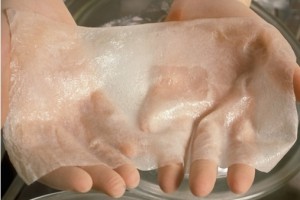Artificial Skin Gives Robots Ability to Feel
Pretty cool stuff coming out of the University of Pittsburgh and the Massachusetts Institute of Technology. Scientists have been studying one of the strangest behaving materials known to man with some amazing potential future applications.
Belousov-Zhabotinsky gel or BZ gel is a self-oscillating (self-moving) gel that is able to change shape without being provoked by an outside force. This sensation is called a Belousov-Zhabotinsky reaction, and is attributed to research conducted all the way back in 1950 by Soviet biophysicist Boris Belousov, with follow-up work in 1961 by graduate student Anatol Zhabotinsky.
What is important to note about the BZ reaction, and what makes it so special, is that the chemicals behave unpredictably for an extended period of time. They in fact, change color and size in awe-inducing fashion. A video can be seen below.
When in motion, the gel has the capability of relaying information regarding the sensation of touch. The problem was, the moving gel eventually came to a standstill. Dr. Anna Balazs, celebrated Professor of Chemical and Petroleum Engineering at Pitt successfully predicted what was later proven by MIT researchers; that a non-oscillating BZ gel could be revived or re-excited by extreme pressure. It now seems that this BZ gel has the real potential to act like our real skin and nerves do, relaying a message to our brain to indicate a sensation of touch or pain. In technical terms, these oscillating gels can “sense mechanical stimuli and respond chemically.” The most important part about these gels is that this is a naturally occurring phenomenon that has seldom been able to be mimicked. Dr. Balazs thinks this research could be the “a holy grail in robotics.”
The somewhat freaky application of this discovery would be utilizing the effect within a robot to enable it to feel certain objects and relay messages back to it’s operator. This could be useful with the increasing number of robo-surgeons, or in scientific explorations of foreign territory on land, sea and space.
What could be the most amazing of uses, though, would be if this information obtained by the gel could be relayed back to a human brain. Could this be a major step towards the human-robot hybrid? Could we implement this self-oscillating BZ gel into prosthetic limbs administered to paraplegics? Could we recreate the sensation of touch in nerves that have been destroyed in fingers? This topic brings up some fascinating discussion. How do you see these findings playing out in the world of science and medicine?
Comments
Tags: artificial skin, bz gel, bz reaction, oscillating gel, self-oscillating gel
Trackback from your site.


Comments (1)
Maven
| #
Wow, this was a little complicated at first but the possibilites are potentially life changing. I would like to understand how the BZ gel transmits the information.
Reply